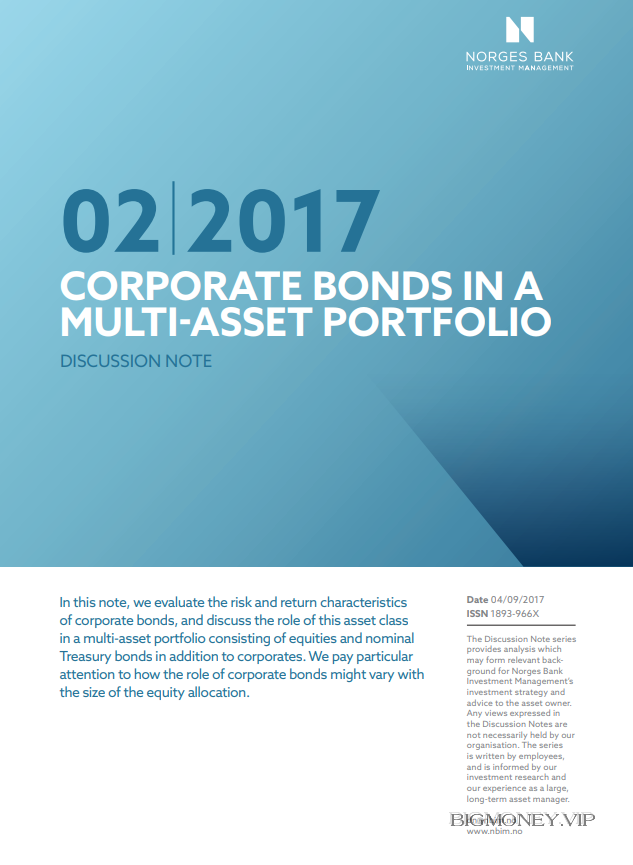02 2017 CORPORATE BONDS IN A MULTI-ASSET PORTFOLIO DISCUSSION NOTE

Introduction
In this note, we evaluate the risk and return characteristics of corporate
bonds, and discuss their role in a multi-asset portfolio consisting of equities
and Treasuries in addition to corporates. This note is a follow-up to DN
2-2016 “Risk and return of different asset allocations”, where we focus on the
interaction between equity and interest rate risk in portfolios with different
combinations of the two risk factors.
Introducing credit risk into the analysis allows us to assess whether corporate
bonds add any value over and beyond Treasuries in an equity-bond portfolio.
Along the same lines as in DN 2-2016, the objective of this note is to shed
light on the risk-return characteristics of corporate bonds as well as the asset
class’s co-movement properties against equities and government bonds. We
pay particular attention to how the role of corporate bonds might vary with
the size of the equity allocation.
We find that corporate bonds have historically enhanced multi-asset portfolio
returns, although whether the enhancement is statistically and economically
significant is highly sample-dependent. Of critical importance for the
portfolio properties of corporate bonds, we find that corporate bond excess
returns have historically been positively correlated to equity excess returns,
while moving counter to excess returns on Treasuries. The multi-asset
portfolio properties of corporate bonds therefore depend crucially on the
initial equity-Treasury mix.
The upshot of this is that credit risk acts as a diversifier in a portfolio
dominated by interest rate risk, while an allocation to corporate bonds has
historically increased the overall volatility of multi-asset portfolios dominated
by equity risk.
Drivers of credit returns
For an investor who has decided on a non-zero corporate bond allocation,
the focus should be on the drivers of the yield difference, or spread, between
corporate and government bonds. A large literature in academic finance,
covering both theory and empirics, attempts to account for the variation in
credit spreads. The literature points to a tight link between credit returns and
drivers of returns in equity and Treasury markets.
A well-documented observation from this literature is that credit spreads
have historically compensated for more than the expected loss from default
using traditional credit models. The reason for this excess spread – termed
the credit spread puzzle – must either be misspecification in the traditional
models or that additional factors drive observed credit spreads.
The focus on credit spreads can be misleading, however. As Ilmanen
(2012) points out, ex-post corporate bond excess returns are found to be
meaningfully lower than implied by ex-ante credit spreads. Using Barclays
data covering the period 1973–2009, Ilmanen finds average realised excess
returns of roughly 30 basis points. Contrasting this number with the average
option-adjusted credit spread of 120 basis points over the same period yields
a significant residual.
Ilmanen (2012) attributes the difference to a host of factors, including the
downgrading bias
, the fallen-angel effect
, differences in realised and
expected defaults, and repricing effects that occur over multi-decade data
samples. The upshot of this is that one should be careful to distinguish
between ex-ante credit spreads and ex-post excess returns. Still, the key to
understanding realised corporate bond returns arguably lies in the drivers of
corporate bond prices and the yield spread over government bonds.
The literature dealing with the valuation of corporate debt starts with the
seminal work of Merton (1974), who applies the option-pricing theory
developed by Black and Scholes (1973) to the modelling of a firm’s value and,
crucially, to pricing corporate bonds. In a nutshell, Merton (1974) lays out
a simple framework where a firm, with a total value V, issues a single zero-
coupon bond with a face value F, and equity is the residual claim on the firm
value. Default occurs at maturity T whenever the firm’s liabilities exceed its
assets (V < F).
The payoff to holders of equity and debt will naturally differ, depending on
whether the firm defaults or not. Starting with the bond holder, the payoff
can either be 1) face value F at maturity whenever V > F, or 2) firm value V
whenever V < F and the firm defaults. On the flipside, this leaves the equity
holder with zero whenever the firm defaults, and V – F otherwise. Merton
(1974) recognises that the payoff to equity holders – max(0, V – F) – is
equivalent to that of a call option on the assets of the firm.
The critical insight from Merton (1974) is perhaps better understood when
applying the put-call parity of Stoll (1969). The put-call parity is a no-arbitrage
condition, which simply states that the market value V of a given underlying
asset must equate to the sum of a call option C with strike price K written on
the asset, a put option P (also with strike K) on the same underlying asset,
and the present value of a risk-free bond B with a face value equal to the
strike price (V = C + P + B).
The risky corporate bond in the Merton framework is therefore equivalent to
a combination of a risk-free bond and a short position in a put option written
on the assets of the firm. This insight allows us to think of the credit spread
– the spread between the risky corporate bond and a comparable risk-free
bond – as a short put option on the firm. While still being a subject of great
controversy in the financial literature, the Merton model clearly establishes a
(positive) link between risk premiums in equity and corporate bond markets.
02 2017 CORPORATE BONDS IN A MULTI-ASSET PORTFOLIO DISCUSSION NOTE




